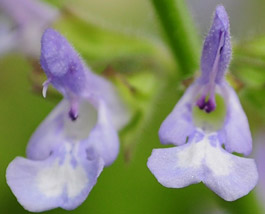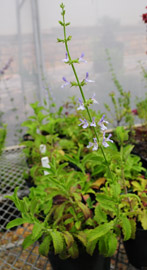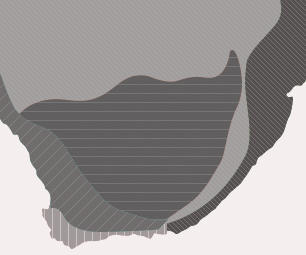Salvia aurita var. aurita
Salvia aurita L.f. var. aurita
Family: Lamiaceae
Common names: oogseerbossie (Afr.)
Introduction
Salvia aurita var. aurita is a fast-growing, herbaceous perennial that makes a fantastic groundcover in gardens that can offer a little summer watering.

Description
Description
Salvia aurita var. aurita is a fast-growing, low-growing, herbaceous perennial. The stems spread out sideways, up to 1.2 m, from a slightly upwardly curved base. The leaves are simple to lyre-shaped with toothed divisions facing backwards (runcinate), or egg-shaped (ovate), with margins crenate (notched with rounded teeth) or dentate (sharply toothed). Both stems and leaves are covered in glandless, fine, curled, dense hairs and oil globules. The foliage is aromatic. Flowers are produced in whorls, at intervals along flowering stems which have floral leaves. These floral leaves are egg-shaped at the base, then elongate and gradually taper to a sharp point (ovate-lanceolate) and have a bract present. The flower is typical of sage with a two-lipped corolla and ranges from pale blue to lilac, white and white blushed with pink. The upper lip is short and straight, equal in length to the lower lip. Flowers are borne in spring and summer.

Black or dark brown, shiny nutlets (1.7 mm in diameter) are visible at the base of the calyx and fall out when ripe. These nutlets do not become moist and sticky when wet.
Conservation Status
Status
Salvia aurita var. aurita is not threatened.
Distribution and habitat
Distribution description
This sage is endemic to southern Africa and occurs over a wide range from the Western Cape through the Eastern Cape, KwaZulu-Natal and Swaziland to Mpumalanga. It occurs at altitudes of 5-1 405 m in moist areas in valleys, open hillsides, renosterveld or along streams and in forests.
Derivation of name and historical aspects
History
Pliny the Elder, a Roman scientist and historian, was the first to use the name Salvia.
The virtues of sages can be found in old herbals (books describing the properties of plants) with woodcuts and engravings published in medieval and Renaissance Europe, giving medicinal recipes or describing charms or spells.
Salvias have been popular since the 1970s for ornamental gardening.
The name Salvia is presumably derived from the Latin, salvus meaning uninjured, whole, safe, well or sound and salvere, to be in good health, referring to the medicinal value of the plants.
The epithet aurita has its origins in the Latin language in which auritus means eared, with or having ears, or with large ears or long-eared, and refers to the ear-like lobes at the base of the leaves.
Synonymy of Salvia aurita var. aurita includes Salvia lasiostachys, S. pallidiflora and S. peglerae.
The two varieties of Salvia aurita are often confused with each other. Salvia aurita var. aurita has simple leaves with fairly indistinct basal lobes, which are egg-shaped (ovate). Salvia aurita var. galpinii has leaves which are divided feather-like (pinnately) into lobes reaching over halfway to the midrib (pinnatipartite), and have distinct basal lobes which are broad and oblong.
Salvia is the largest genus in the Lamiaceae family. It consists of approximately 900 species made up of annuals, perennials and shrubs. They are widely distributed around the world in warm temperate and tropical regions. 27 species are found naturally in southern Africa. Noteworthy southern African sages are Salvia africana-lutea, S. africana-caerulea, S. chamelaeagnea, S. muirii and S. disermas. Sages are commonly grown as ornamentals.
Ecology
Ecology
Bees, butterflies and other insects are attracted to Salvia flowers.
Uses
Use
Most sages contain essential oils and have long been used in cooking and medicine all over the world. Salvia aurita var. aurita makes a wonderful, fast-growing, flowering, and seasonal groundcover.
Growing Salvia aurita var. aurita
Grow

This sage is used as a perennial for summer displays. Its low, lush foliage can be used as a groundcover in moist, open beds and can create an attractive cascade of foliage in deep, well watered containers.
Young plants are planted out at the end of spring. Salvia aurita var. aurita is easily combined with most flowering perennials and also gives good contrast with Fynbos elements such as Restionaceae, Proteaceae and Erica species.
The fast-growing plants get untidy after each growth period in summer and need to be pruned back hard. From time to time, it will be beneficial to maintain the growing area of the plants by removing excessive spreading side stems and to use these rooted shoots to propagate more plants, or give them to fellow gardeners to replant for their own use.
Salvia aurita var. aurita requires full sun with good drainage. It will survive with moderate water, but responds well to regular watering, especially in summer. No extra feeding is necessary for strong, healthy growth and flowering, although an occasional foliar feed would do no harm and the plants will tolerate feeding with organic or chemical fertilizers.
Young plants are easy to propagate from seed, cuttings or divisions of the creeping rootstock.
Sow seeds in late spring and early summer into general potting soil mix. Seedlings germinate quickly, and seedlings can be transplanted into well-drained potting soil once the first pair of true leaves appears.
Take tip cuttings in spring and summer. Cuttings must be without a terminal flowering bud. Place in rooting medium: 50% fine milled bark and 50% polystyrene (perlite, vermiculite, river sand and peat are alternatives). Place under mist or enclose in a plastic bag to retain humidity. Keep warm but out of direct sunlight, and cuttings should root in 2-4 weeks.
Due to their hairy and aromatic leaves the plants do not have any major pests, although mealy bugs may settle down near the base of the stems and leaves.
References
- Hedge, I.C. 1974. Revision of Salvia in Africa including Madagascar and Canary Islands. Notes from the Royal Botanic Garden Edinburgh 33(1).
Credits
Monique McQuillan
Kirstenbosch National Botanical Garden
October 2011
Plant Attributes:
Plant Type: Perennial
SA Distribution: Eastern Cape, KwaZulu-Natal, Limpopo, Western Cape
Soil type: Sandy, Clay, Loam
Flowering season: Spring, Early Summer, Late Summer
PH: Acid, Neutral
Flower colour: Mauve/Lilac
Aspect: Full Sun, Morning Sun (Semi Shade), Afternoon Sun (Semi Shade)
Gardening skill: Easy
Special Features:
Horticultural zones










Rate this article
Article well written and informative
Rate this plant
Is this an interesting plant?
Login to add your Comment
Back to topNot registered yet? Click here to register.